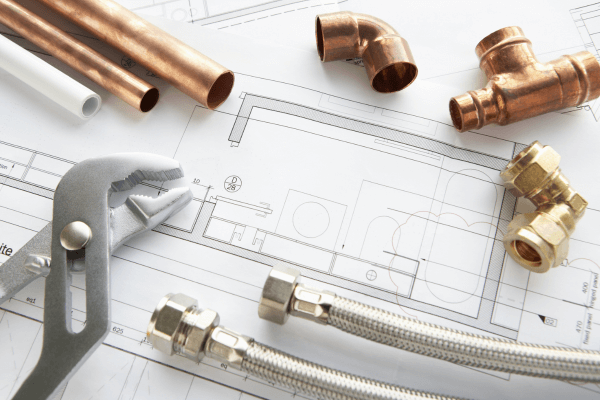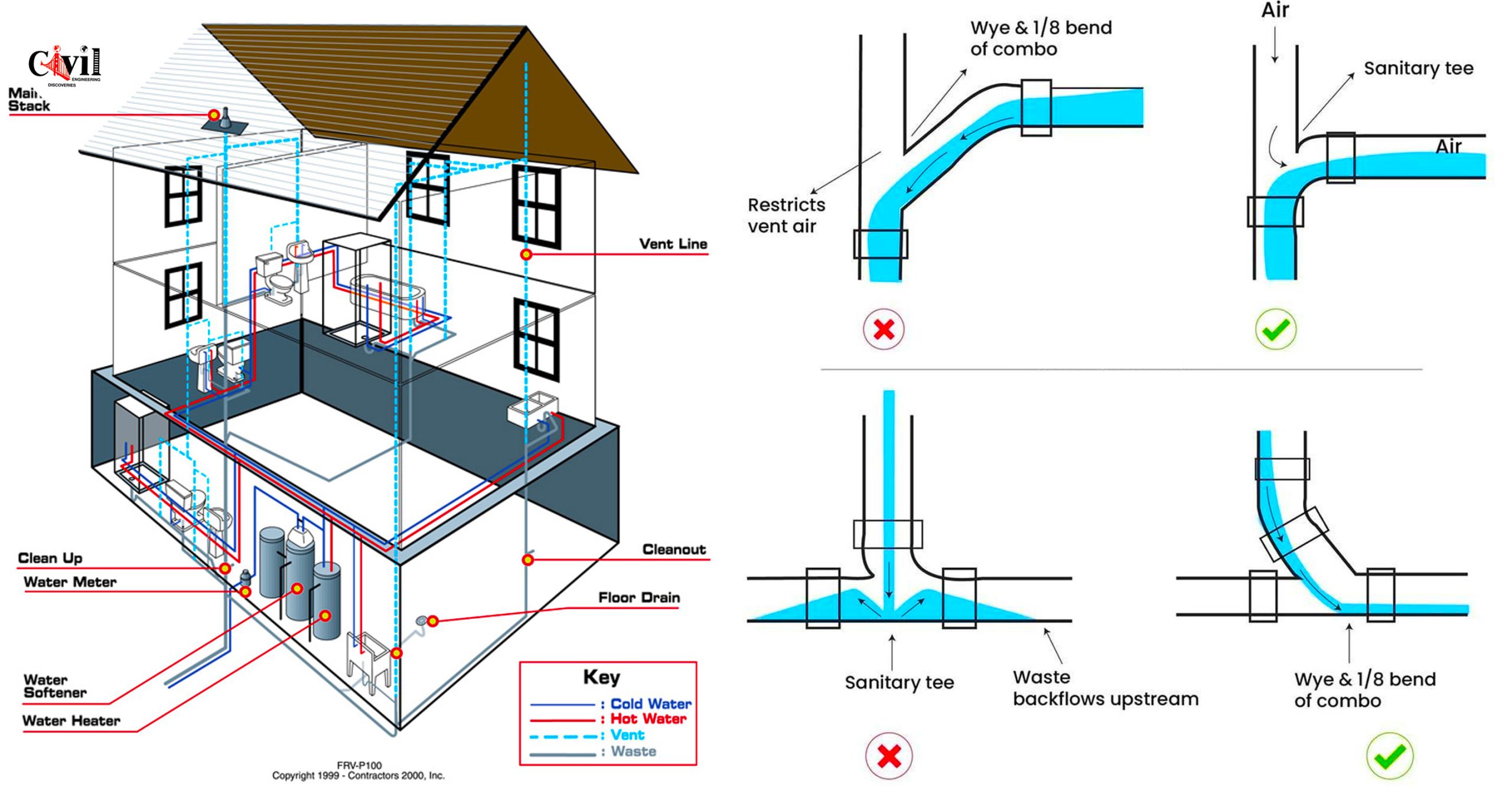Everything You Need to Know to Your Home's Plumbing System Anatomy
Everything You Need to Know to Your Home's Plumbing System Anatomy
Blog Article
This post listed below on the subject of Anatomy of a House: Understanding the Components is relatively intriguing. Give it a try and make your own personal conclusions.

Understanding just how your home's plumbing system functions is essential for each homeowner. From providing tidy water for drinking, cooking, and bathing to securely removing wastewater, a well-maintained plumbing system is vital for your family members's health and convenience. In this extensive overview, we'll check out the detailed network that makes up your home's plumbing and deal pointers on maintenance, upgrades, and dealing with common problems.
Intro
Your home's pipes system is more than just a network of pipes; it's a complicated system that guarantees you have accessibility to tidy water and efficient wastewater removal. Understanding its elements and just how they work together can help you protect against costly repairs and guarantee whatever runs smoothly.
Basic Components of a Plumbing System
Pipes and Tubes
At the heart of your pipes system are the pipelines and tubes that lug water throughout your home. These can be constructed from numerous materials such as copper, PVC, or PEX, each with its benefits in regards to durability and cost-effectiveness.
Components: Sinks, Toilets, Showers, and so on.
Components like sinks, commodes, showers, and bath tubs are where water is used in your home. Recognizing how these fixtures link to the pipes system aids in diagnosing problems and planning upgrades.
Shutoffs and Shut-off Points
Valves manage the circulation of water in your pipes system. Shut-off shutoffs are critical during emergencies or when you need to make repair services, permitting you to separate parts of the system without interfering with water circulation to the whole house.
Water System
Main Water Line
The primary water line links your home to the local water supply or a private well. It's where water enters your home and is dispersed to numerous components.
Water Meter and Stress Regulator
The water meter steps your water use, while a stress regulator guarantees that water flows at a safe stress throughout your home's pipes system, avoiding damage to pipelines and fixtures.
Cold Water vs. Warm water Lines
Recognizing the difference between cold water lines, which supply water straight from the primary, and hot water lines, which carry warmed water from the hot water heater, helps in troubleshooting and preparing for upgrades.
Drainage System
Drain Pipes and Traps
Drain pipes carry wastewater far from sinks, showers, and commodes to the sewage system or septic system. Catches stop drain gases from entering your home and likewise trap debris that could cause obstructions.
Air flow Pipelines
Air flow pipes allow air into the drain system, stopping suction that could reduce drain and create traps to vacant. Proper air flow is vital for maintaining the honesty of your plumbing system.
Importance of Appropriate Water Drainage
Making sure proper water drainage avoids back-ups and water damages. Consistently cleaning up drains pipes and preserving catches can stop costly repair services and extend the life of your pipes system.
Water Heater
Kinds Of Water Heaters
Hot water heater can be tankless or standard tank-style. Tankless heaters warmth water as needed, while tanks save warmed water for immediate usage.
Exactly How Water Heaters Connect to the Pipes System
Comprehending just how water heaters connect to both the cold water supply and warm water distribution lines aids in identifying issues like inadequate hot water or leakages.
Maintenance Tips for Water Heaters
Regularly purging your water heater to get rid of sediment, examining the temperature setups, and examining for leakages can prolong its life expectancy and improve energy efficiency.
Common Plumbing Issues
Leaks and Their Causes
Leaks can happen due to aging pipelines, loosened installations, or high water stress. Addressing leakages without delay avoids water damage and mold and mildew growth.
Obstructions and Blockages
Obstructions in drains pipes and toilets are usually triggered by flushing non-flushable products or a buildup of oil and hair. Utilizing drain displays and being mindful of what drops your drains can prevent blockages.
Signs of Pipes Issues to Expect
Low water stress, sluggish drains, foul odors, or uncommonly high water bills are indications of potential pipes problems that must be addressed quickly.
Pipes Maintenance Tips
Normal Evaluations and Checks
Set up annual pipes inspections to capture issues early. Try to find signs of leaks, deterioration, or mineral accumulation in taps and showerheads.
DIY Upkeep Tasks
Simple tasks like cleansing faucet aerators, looking for commode leakages using dye tablet computers, or shielding exposed pipelines in cool climates can stop significant plumbing problems.
When to Call a Specialist Plumbing
Know when a plumbing problem calls for professional knowledge. Trying intricate repair work without appropriate expertise can lead to more damages and greater repair work costs.
Upgrading Your Pipes System
Factors for Upgrading
Upgrading to water-efficient components or changing old pipelines can improve water top quality, reduce water bills, and enhance the worth of your home.
Modern Pipes Technologies and Their Benefits
Explore innovations like wise leakage detectors, water-saving commodes, and energy-efficient water heaters that can save money and minimize ecological influence.
Cost Factors To Consider and ROI
Compute the ahead of time costs versus long-term savings when thinking about pipes upgrades. Lots of upgrades spend for themselves via reduced utility bills and fewer repair work.
Environmental Effect and Conservation
Water-Saving Components and Home Appliances
Mounting low-flow taps, showerheads, and commodes can dramatically lower water use without sacrificing performance.
Tips for Decreasing Water Usage
Simple behaviors like fixing leaks immediately, taking much shorter showers, and running complete loads of laundry and dishes can conserve water and lower your utility costs.
Eco-Friendly Pipes Options
Take into consideration lasting plumbing materials like bamboo for floor covering, which is durable and environment-friendly, or recycled glass for counter tops.
Emergency situation Readiness
Steps to Take Throughout a Pipes Emergency
Know where your shut-off valves lie and how to turn off the water supply in case of a ruptured pipe or major leakage.
Significance of Having Emergency Situation Calls Useful
Maintain call info for local plumbing professionals or emergency solutions readily offered for fast reaction throughout a plumbing dilemma.
Do It Yourself Emergency Fixes (When Suitable).
Short-term solutions like utilizing air duct tape to patch a dripping pipe or placing a container under a dripping tap can minimize damage till a professional plumbing professional arrives.
Verdict.
Understanding the makeup of your home's plumbing system encourages you to maintain it successfully, saving time and money on fixings. By complying with normal maintenance regimens and remaining notified concerning modern plumbing modern technologies, you can guarantee your plumbing system operates effectively for several years ahead.
HOW YOUR PLUMBING SYSTEM WORKS
Which Pipes Do What?
Blue lines = fresh water supply entering the building
Red lines = hot water supply entering the building
Grey lines = pipes carrying waste away from the building and venting pipes carrying gases away from the building (through the roof)
YOUR MAIN PLUMBING SYSTEMS
There are two main plumbing systems that support your home s basic plumbing needs one that brings clean water into your home, and one that sends dirty water away from your home. Connected to the toilet, bath, shower, and other faucets in your home, these two systems keep your water flowing in the right directions.
ACCESSING FRESH WATER
Fresh and clean water is brought into your home through the main water supply line . Filtered through one pipe, this water is pressured to flow into the various fixtures in your home at any given time.
This water can be sourced from a well located on your property, a pond or river (mostly cottages), or, as in most cases, from the city s municipal water treatment centre. However, it is important to note that water that is untreated, such as the water siphoned from ponds or rivers, may not be safe to drink. Personal water supplies always need to be treated for hardness and contaminants before consumed.
MUNICIPAL WATER SUPPLIES
Improve taste and odour
Remove sediment
Eliminate hardness
Reduce chlorine
COLD WATER SUPPLY VS. HOT WATER SUPPLY
Cold water flows into your home or building through the service line, which then distributes hot or cold water to your fixtures. This line is most commonly run through a central column that runs floor to floor. Hot water runs in short and straight pipes as the longer the pipeline, the more heat that will be lost in the transfer. Having shorter pipes also allows residents to access hot water more quickly.
WASTE WATER SYSTEM
Your wastewater system is divided into two parts pipes that send wastewater away from your home and venting pipes that send sewer gas away from your home. Sewage water travels through pipes that flush the water and waste towards local sewers that are operated and managed by your city or town. Most sewer systems rely on gravity to move the wastewater to where it needs to go.
The further away from your toilet or sink, the larger wastewater pipes become. This allows for waste to be disposed of from various parts of your home or business at once without pipe blockages. The angle and flow of these pipes are also essential for keeping your waste pipes clear of build up.
https://harrisplumbing.ca/how-your-home-plumbing-system-works/

HOW YOUR PLUMBING SYSTEM WORKS
Which Pipes Do What?
YOUR MAIN PLUMBING SYSTEMS
There are two main plumbing systems that support your home s basic plumbing needs one that brings clean water into your home, and one that sends dirty water away from your home. Connected to the toilet, bath, shower, and other faucets in your home, these two systems keep your water flowing in the right directions.
ACCESSING FRESH WATER
Fresh and clean water is brought into your home through the main water supply line . Filtered through one pipe, this water is pressured to flow into the various fixtures in your home at any given time.
This water can be sourced from a well located on your property, a pond or river (mostly cottages), or, as in most cases, from the city s municipal water treatment centre. However, it is important to note that water that is untreated, such as the water siphoned from ponds or rivers, may not be safe to drink. Personal water supplies always need to be treated for hardness and contaminants before consumed.
MUNICIPAL WATER SUPPLIES
COLD WATER SUPPLY VS. HOT WATER SUPPLY
Cold water flows into your home or building through the service line, which then distributes hot or cold water to your fixtures. This line is most commonly run through a central column that runs floor to floor. Hot water runs in short and straight pipes as the longer the pipeline, the more heat that will be lost in the transfer. Having shorter pipes also allows residents to access hot water more quickly.
WASTE WATER SYSTEM
Your wastewater system is divided into two parts pipes that send wastewater away from your home and venting pipes that send sewer gas away from your home. Sewage water travels through pipes that flush the water and waste towards local sewers that are operated and managed by your city or town. Most sewer systems rely on gravity to move the wastewater to where it needs to go.
The further away from your toilet or sink, the larger wastewater pipes become. This allows for waste to be disposed of from various parts of your home or business at once without pipe blockages. The angle and flow of these pipes are also essential for keeping your waste pipes clear of build up.
https://harrisplumbing.ca/how-your-home-plumbing-system-works/
I'm just very drawn to and I really hope you appreciated our blog posting. Do you know somebody else who is inquisitive about the niche? Do not hesitate to share it. Thank-you for going through it.
Pricing Report this page